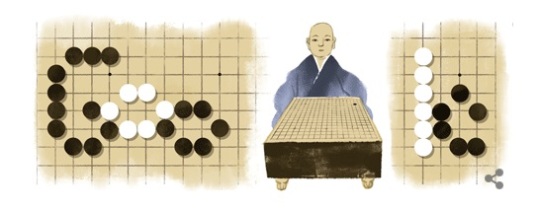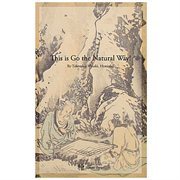All about Influence in GO/Weiqi/Baduk
biographies
Memories from 100 years with GO SEIGEN (✞ 30th Nov 2014)
… with courtesy by The Nihon Ki-in (Japan Go Association)
Go Seigen (呉清源 ) – Memories of Go Master!
- legend GO SEIGEN (12th Jun 1914 – 30th Nov 2014)
- … vs. Honinbo Shusai Meijin
- … vs. Fujisawa Kuranosuke (Jubango)
- … vs. Kitani Minoru (Kamakura Jubango)
- … teaching the disciple Rin Kaiho
- … reviewed the game with the players: Hashimoto Utaro and Fujisawa Shuko (1st of Kisei title match)
- … with Fujisawa Shuko in Beijing (for the 1st ING Cup)
- … with Kitani and their daughters
- … in 21st century: teaching Ogawa Tomoko
- … visiting and watching the Kisei title match 2012 (1)
- … visiting and watching the Kisei title match 2012 (2)
- … visiting and watching the Kisei title match 2013 (with Fujisawa Rina)
(Source: 1st Dec 2014 – FB Photo album @ The Nihon Ki-in (Japan Go Association) | Go Seigen (呉清源 ) – Memories of Go Master!)
Related Articles…
- R.I.P. and a deep bow for a real legend: 100 year old GO SEIGEN (12th Jun 1914 – 30th Nov 2014) is no more (https://mysanrensei.wordpress.com/)
- The Japan News (1st Dec 2014): Go master Seigen Go dies (http://the-japan-news.com)
- Retired pro go player Go Seigen dies at 100 (http://mainichi.jp/)
- Legendary Go master Wu Qingyuan dies at 100 (http://www.shanghaidaily.com/)
- South China Morning Post: Legendary Go grandmaster Wu Qingyuan dies at 100 (http://www.scmp.com/)
- Go master: The board is my homeland (http://the-japan-news.com/)
- Go master passes at age 100 (http://www.globaltimes.cn/)
- Game of Go Sensation Wu Qingyuan Dies at 100 (http://english.cri.cn/)
R.I.P. and a deep bow for a real legend: 100 year old GO SEIGEN (12th Jun 1914 – 30th Nov 2014) is no more
In summer 2014 the Go community around the world celebrated GO Seigen’s 100th birthday. (Rec.: Already since the 99th birthday in 2013 the Go lovers around the globe promoted to present a specific Google Doodle on 12th June 2014 (see image).)
Sadly the Spanish version of Wikipedia just reported 1.5 hour ago that Go Seigen, the uniquely legend of GO is no more. Go Seigen died on early Sunday morning, 30th November 2014 in a hospital (in Odawara, Kanagawa Prefecture) at the age of 100, so noticed by The Japanese News on 1st December early morning (Japanese local time) .

Go Seigen (left) at young age playing his teacher Segoe Kensaku (source: GoGameGuru 06/2013)
Wu Qingyuan (simplified Chinese: 吴清源; traditional Chinese: 吳清源; pinyin: Wú Qīngyuán; (June 12, 1914 – November 30th, 2014), generally known in the West by his Japanese name Go Seigen, is considered by many players to be the greatest player of the game of Go in the 20th century. He turned 100 in June 2014.
Biography
Born in Fuzhou, Fujian Province, southeast China, Go Seigen did not start learning the game of Go until he was nine, a relatively late age for a professional (Honinbo Dosaku first learned Go at seven and Honinbo Shusaku before he was six). His father, who had taken Go lessons from Honinbo Shuho while studying in Japan, was responsible for introducing him to the game. Go Seigen quickly excelled and soon became known as a Go prodigy. By the time he was 12, less than three years after first learning the game, he was already of professional strength, as evidenced by his games against the visiting Japanese player Iwamoto Kaoru, 6p in 1926. The next year, he was able to reach a draw in a two-game match against another Japanese professional, Inoue Kohei, 5p. In 1928, still only 14 years old, he twice defeated Hashimoto Utaro, 4p. Go Seigen’s reputation spread to Japan, then the leading Go powerhouse, and a movement was started there to bring him to Japan. He subsequently immigrated to Japan in 1928, at the invitation of Baron Kihachiro Okura and Inukai Tsuyoshi (later prime minister of Japan), and embarked on a professional career. He was tutored by Segoe Kensaku, the same teacher as Hashimoto Utaro and Cho Hunhyun.

Go Seigen Turns 100, Keeps On Playing (Source: 06/2014 – American Go E-Journal)
Go Seigen began his rise to the top of professional Go world early. By the time he was 18 he was already a top-flight player belonging to a very small elite. In 1933, along with his great friend Kitani Minoru, Go Seigen developed and popularized the Shinfuseki that broke away from the traditional opening patterns. It is for this very important contribution that Go Seigen and Kitani Minoru are recognized as the fathers of modern Go.
Starting in 1939, Go Seigen began a spectacular series of Jubango matches against other top players of the day. It was through these matches that Go Seigen convincingly demonstrated an overwhelming dominance over his contemporaries. Go Seigen had only one formal disciple – Rin Kaiho, Honorary Tengen. Go Seigen’s star began to fade in the early 1960s due to health reasons and he had to virtually retire from playing professional Go by 1964. However, Go Seigen remained active in the Go community through teaching, writing, and promoting Go around the world.
Professional Record
Go Seigen is commonly considered to be among the best to have ever played the game and the best player of the 20th century. He dominated professional Go for more than a quarter of a century. He maintained a brilliant match record and successively defeated all the leading players of the day in a series of notable jubango (contest between two players consisting of ten games), even forcing them down to handicaps. Some of the defeated were Kitani Minoru, Karigane Junichi, Hashimoto Utaro,Iwamoto Kaoru, Fujisawa Hosai, Sakata Eio, and Takagawa Kaku. Go lost just one jubango, and that was against Fujisawa Hosai. However, the match was played with Fujisawa taking the josen handicap throughout, and Fujisawa only managed to win with a score of 6 to 4. Some ten years later, Go Seigen took revenge on Fujisawa by beating him in two consecutive jubango with lopsided scores of 7-2 and 5-1 respectively. One must note that these jubango matches were all played without komi, and indeed the same applied to the vast majority of games Go Seigen played during his career. Go Seigen won the Oteai six times, and won a special Nihon Ki-inchampionship tournament in 1933.

Go Seigen (吳清源) Source: Sensei’s Library
You find a table of Go’s jubango records on Wikipedia.org (ENG).
Style
Go Seigen was notable for his fast-paced development & playing, fighting style, positional judgment and accurate reading. He settled his groups quickly, got to the big points first, and regularly used much less time in a game than his opponents. He was exceptional at using thickness and making large exchanges. His reading was fast and accurate, and his intuition and positional judgment were often praised. It was also noted that he rarely lost a ko fight that he initiated. Like many players of his time he mastered the Shusaku Opening before switching to his later style.
Theory
In addition to being a peerless match player, Go Seigen has also made great contributions to Go theory, especially in the area of fuseki. He is well known, along withKitani Minoru, as one of the two leading exponents and innovators of the shinfuseki, a period of revolutionary experimentation in the opening of the game that broke away from traditional moves. Go attributed some of his ideas to Honinbo Shuei, for whom he had much respect. As a result of their substantial contributions to Go theory, Go Seigen and Kitani Minoru are regarded as the founders of modern Go. He was inventor of the notable and revolutionary uchimagari (inward bending)avalanche joseki variation. It was first played during a match against Takagawa Kaku in 1957.
Matches against the Honinbos
During the 1950s, apart from playing the jubango, Go Seigen participated in many three-game special matches against the Honinbo title holders and other notable players. His opponents in these matches included many illustrious names, such as Hashimoto Utaro, Sakata Eio, Takagawa Shukaku, and the ex-Honinbo Iwamoto Kaoru. Go Seigen was also matched against Kubouchi Shuchi, a player from the Kansai Ki-in who had a strong individual style. In these matches, Go Seigen demonstrated an equal dominance over his rivals. He had an excellent record against Takagawa, whose main achievement was winning the Honinbo title for nine consecutive years. In the period between 1951 and 1960, Go won 22 of their games, and Takagawa won 13. By 1960, Sakata had emerged as Go Seigen’s most serious rival, but the results of their games between 1950 and 1960 told the same kind of story. Go had 14 wins to Sakata’s 9 and one jigo, or draw. It’s very important to note that in the games they played then, there was no Komi (in modern era, Black’s initial advantage of moving first is offset by komi of 6.5-7.5 points). Because Go Seigen held white most of the time, his record is even more impressive than it appears.
Notable game against Honinbo Shusai
In 1933, Go Seigen won a special Nihon Ki-in tournament to have the opportunity to play a game against Honinbo Shusai Meijin. At that juncture, Honinbo Shusai embodied the highest Go authority and tradition in Japan. In addition to inheriting the hereditary title ofHoninbo, he was also the holder of the prestigious position of Meijin. The game between Go Seigen and Shusai was thus highly anticipated. The newspapers thought it would be a good business idea to publicize the game as a confrontation between Japan and China. As a consequence, Go Seigen became the unfortunate victim of rising Japanese nationalism. Before and during the game, he was often harassed and threatened by nationalists, and the windows of his house were smashed in.
The game itself began on October 16, 1933 with Go Seigen taking black and lasted for a period of almost three months. During the opening of the game, Go Seigen caused quite a sensation by playing his first three moves at 3-3 (San San), 4-4 (Hoshi) and center (Tengen) points. Such a fuseki had never before been witnessed in a professional game, and the newspapers covering the game recorded top sales all throughout the match. This marked one of the seminal events that pushed the “Shin Fuseki” movement into the mainstream.
The match ended with Honinbo Shusai winning by two points. However, his victory was surrounded by controversies. At the time of the match, the tradition dictated that the player holding white had the right to adjourn the game at anytime, and there was no sealing of moves before adjournment. This meant that Shusai, being the nominally stronger player and thus holding white, could adjourn the match whenever it was his turn to move and continue deliberating at home before the match resumed. Shusai shamelessly abused this privilege by adjourning the game more than a dozen times, all at his turn to play. For instance, on the eighth day of the match, Shusai played first, and Go Seigen replied within two minutes, Shusai then thought for three and a half hours, only to adjourn the game. It was no secret that Shusai, during adjournments, discussed and studied the game with his students to come up with the best moves. Go Seigen was therefore put into an especially adverse position for having to take on the entire Honinbo establishment.
Shusai had been trailing all throughout the match when, on the 13th day of the game, he made a brilliant move that in a single stroke brought him back into the game and guaranteed his victory. However, it was widely rumored that it was not Shusai but one of his students – Maeda Nobuaki – who authored this ingenious move. Even Maeda himself hinted that this move was indeed his idea. Years later, when presented with the opportunities to debunk this rumor, he neither confirmed nor denied it. The game became known as the game of the century.
Five years later in 1938, Go Seigen’s great friend Kitani Minoru also played a notable game against Honinbo Shusai (see The Master of Go by Yasunari Kawabata). Due in no small part to having witnessed the treatment Go Seigen received from Shusai in their previous match, Kitani Minoru demanded that the moves be sealed before each adjournment. Initially, Shusai’s camp opposed this, but Kitani vehemently insisted, and Shusai eventually gave in. Kitani won that game by a comfortable margin of five points.
Rank Promotion Record
| Rank | Year | Notes |
|---|---|---|
| 1 dan | (Was given 3 dan when turning professional.) | |
| 2 dan | (Was given 3 dan when turning professional.) | |
| 3 dan | 1929 | Ranking conferred after a series of evaluation games. |
| 4 dan | 1930 | |
| 5 dan | 1932 | |
| 6 dan | 1934 | |
| 7 dan | 1939 | |
| 8 dan | 1942 | |
| 9 dan | 1950 | Via special recommendation by the Nihon Kiin. |
Tournament Victories & Runners-up
Go was often not allowed or invited to participate in the Japanese tournaments of the day due to political reasons involving his racial background. Additionally, half of Go’s career was before the rise of title matches. As such, there are very few title or tournament victories by him. Nonetheless, his strength was most aptly demonstrated in his famed one-on-one matches with the peers of his day.
| Title | Won | Runner-up |
|---|---|---|
| 6-dan Winners’ Oteai | 1936 | |
| All-Japan Go Championship | 1935 | |
| Japan Championship (Yomiuri Shinbunevent) | 1933 | |
| NHK Cup | 1976 | |
| Old Meijin | 1962 | |
| Oteai | 1930 (Autumn), 1931 (Autumn), 1932 (Spring), 1933 (Autumn), 1935 (Spring), 1942 (Spring), | 1932 (Autumn), 1933 (Spring), 1934 (Spring) |
| Saikyo | 1958, 1961 (tied with Sakata Eio) |
Awards…
| Award | Years Won |
|---|---|
| Honorary Member of the Nihon Ki-in | 1983? |
| Okura Prize | 1967 |
End of Carreer and Retirement
In the summer of 1961, Go Seigen was struck by a motorcycle and was hospitalized for two months and again for a longer period a year later. He suffered nerve damage, and his stamina and concentration greatly deteriorated as a result. The accident marked the beginning of the end for Go Seigen’s career, as he was unable to play effectively in grueling long matches due to nausea and dizziness. He gradually played less and less and went into virtual retirement in 1964, although he did not “officially” retire until 1983.
Since retirement, Go Seigen has remained active in the Go community by teaching, writing, and promoting the game around the world. He has authored a number of books on Go, some of which include A Way of Play for the 21st Century, Modern Joseki Application Dictionary, and Fuseki and Middle-game Attack and Defence. Go Seigen still holds study sessions with other professional players such as O Rissei, Michael Redmond, Rui Naiwei, and others.
In 1987, Go Seigen was awarded the Grand Cordon of the Order of the Rising Sun, 3rd Class, Gold Rays with Neck Ribbon for his lifetime contributions to the game of Go.
In 1999 Mr. Teramoto, Go Seigen’s manager, told Go writer Pieter Mioch “He [Go Seigen] is one of three Go players who will still be notable several hundred years from now. The other two are Dosaku (1645 – 1702) and Shusaku (1829 – 1862).”
Chinese film director Tian Zhuangzhuang filmed a 2006 biopic on Go Seigen entitled The Go Master.
Go Seigen died on 30th November 2014 (Sunday morning), in Odawara, Kanagawa Prefecture, Japan.
(Source: 12/2014 – Wikipedia.org)
Related Articles…
- The Japan News (1st Dec 2014): Go master Seigen Go dies (http://the-japan-news.com)
- Memories from 100 years with GO SEIGEN (✞ 30th Nov 2014) (https://mysanrensei.wordpress.com/)
- Retired pro go player Go Seigen dies at 100 (http://mainichi.jp/)
- Legendary Go master Wu Qingyuan dies at 100 (http://www.shanghaidaily.com/)
- South China Morning Post: Legendary Go grandmaster Wu Qingyuan dies at 100 (http://www.scmp.com/)
- Go master: The board is my homeland (http://the-japan-news.com/)
- Go master passes at age 100 (http://www.globaltimes.cn/)
- Game of Go Sensation Wu Qingyuan Dies at 100 (http://english.cri.cn/)
Trailer “The Go Master” (2006)…
Takemiya Masaki (9P) and his early Go carreer in the 70th… 12 games (1969-1981)
To get a better understanding about San-RenSei and Cosmic Style lets have a more detailled look at Takemiya Masaki and his early Go carreer in the 70th.
This is Go the Natural Way
I’d like to reference to This is Go the Natural Way, an interesting recompilation of articles (commented games) which had been published originally in the Kido Magazine. (Rec.: Kido was for many years since Oct. 1924 the dan-level go magazine of Nihon Ki-in (Japan Go Institute). The publishing was released in 1999/2000.).
Further This is Go the Natural Way contains an appreciation of Takemiya’s style by Ishida Yoshio who was his opponent different times with drawing on a different sample of games, records of which are included in a supplement, and some minor extras.
author: Takemiya Masaki
publisher: Hinoki Press
1st print: 2008
ISBN-13: 978-0-9788874-9-0
176 pp.
[Rec.: Available in different online shops within a prize range from 20-53 US dollars / 23-54 Euros (plus fees (shipping costs, vat…)), e.g. on Amazon, Alibris, Abebooks.]
Twelve games in total are coveringe the time period from 1969 to 1981. Following list gives the white player first (source: [Sensei’s Library][5]):
1. Takemiya Masaki – Hashimoto Utaro, 1972-08-08, All Japan No. 1
2. Tournament Kato Masao – Takemiya Masaki, 1974-05-18/19, Honinbo
3. League Takemiya Masaki – Rin Kaiho, 1974-03-28, Pro Best Ten Final
4. Takemiya Masaki – Abe Yoshiteru, 1977-10-06, Oteai
5. Ishida Yoshio – Takemiya Masaki, 1970-12-20/21, Nihon Ki-in Championship
6. Hashimoto Shoji – Takemiya Masaki, 1969-05-22, Pro Best Ten
7. Ishida Yoshio – Takemiya Masaki, 1974-03-03, Nihon Ki-in Championship
8. Yamabe Toshiro – Takemiya Masaki, 1970-06-04, Nihon Ki-in Championship
9. Ishida Yoshio – Takemiya Masaki, 1974-03-30/31, Honinbo Title Match, Game Two
10. Takemiya Masaki – Rin Kaiho, 1974-01-23/24, Honinbo
11. Takemiya Masaki – Honda Kunahisa, 1974-01-14, Meijin League
12. Takemiya Masaki – Cho Chikun, 1981-05-26, Honinbo Title Match, Game 1
To give you a first idea you can go through three of these twelve games against some legendary Go players Takemiya Masaki had played in 1970, 1974 and 1981. All games he won as white and black are available for your individual review on OGS, too (see links under the SGF Screenshot/viewer).



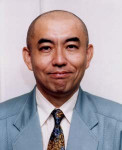
[f.l.t.r.: Yamabe Toshiro (1926-2000) / Cho Chikun (born 1956) / Rin Kaiho (born 1942) Takemiya Masaki (born 1951)]
(A) Nihon Ki-in Championship (1970-06-04): Yamabe Toshiro [6] (white) – Takemiya Masaki (black)
With this game we can see that the 20 year young Takemiya M. (born 01/01/1951) who became a 1 Dan Professional in 1965 already played the classical San-RenSei opening with 3 star points.
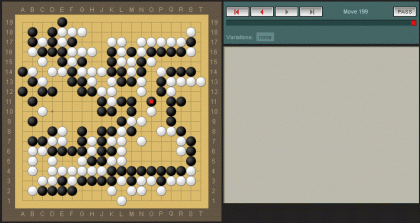
1970-06-04-eidogo.sgf (1.4 KB)
For your individual review / Go training you can pick up the SGF here: Eidogo | OGS
(B) Honinbo (1974-01-23/24): Takemiya Masaki (white) – Rin Kaiho [7] (black)
In this game Takemiya played from left side first with two 4-4 corner stones and then attacking black’s bottom right corner. Lately with move 28 he settled a stronger basis on left side to expand a first wing on bottom inside for a bigger moyo.
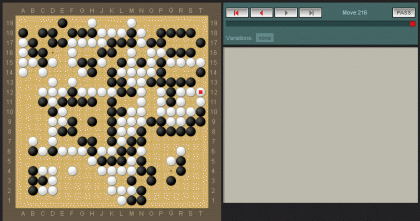
1974-01-23-eidogo.sgf (1.4 KB)
For your individual review / Go training you can pick up the SGF here: Eidogo | OGS
(C) Honinbo Title Match (game 1 / 1981-05-26): Takemiya Masaki (white) – Cho Chikun [8] (black)
This game in the beginning of the 80th shows a very different Takemiya, with white as a territory player.
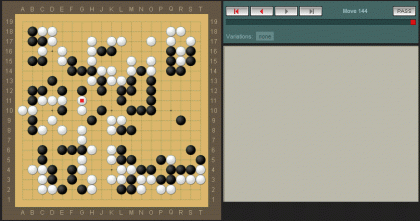
1981-05-26-eidogo.sgf (1.0 KB)
For your individual review / Go training you can pick up the SGF here: Eidogo | OGS
[1]: http://senseis.xmp.net/?TakemiyaMasaki
[2]: http://gowizardry.com/?page_id=8
[3]: http://senseis.xmp.net/?NihonKiIn
[4]: http://www.isbns.la/isbn/9780978887490
[5]: http://senseis.xmp.net/?ThisIsGoTheNaturalWay
[6]: http://senseis.xmp.net/?YamabeToshiro
[7]: http://en.wikipedia.org/wiki/Rin_Kaiho
[8]: http://senseis.xmp.net/?ChoChikun












